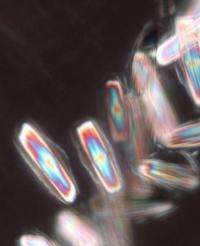A plant's arsenal of crystalline darts and sand

Pet owners have heard the warnings to keep certain poisonous houseplants away from their pets, such as Dieffenbachia (dumbcane), Philodendron, peace lily, and pothos. For houseplants like these and others, the problem may not just be a poison, but the presence of tiny crystals throughout the plant.
A discussion of plants may not bring to mind crystals; however, crystals are found in hundreds of plant families. Despite this, their purpose is not well-understood. Hypotheses include acting as a deterrent to herbivory, serving as a long-term storage depot for calcium, or providing extra support to various plant tissues.
To help elucidate the role of crystals in plants and determine whether this role may actually be to prevent animals from munching on the plant, Dr. Gary Coté studied the variety and locations of crystals found in the houseplant Dieffenbachia seguine. His findings have just been published in the July 2009 issue of the American Journal of Botany.
Three common types of crystals are found in plants: druses (spherical crystal aggregates), raphides (long pointed needles found in bundles), and prisms. Coté found all three of these in Dieffenbachia. He discovered that each type of tissue within the plant, as well as different portions of the same organ in some instances, had their own specific crystals. And, despite the variety of crystal structures found throughout the plant, all crystals were found to contain calcium oxalate, the same substance comprising kidney stones.
Dr. Cote's findings suggest that the most common role for crystals may be to act as a deterrent to herbivory, with different types of crystals performing different roles in protecting the plant. The druses, found throughout the plant, would abrade the mouth of any animal unfortunate enough to take a bite of the plant, creating a sensation of chewing sand. The needle-like raphides are most commonly found in leaves, the part of the plant most likely to be eaten. The act of chewing the leaves can result in the forcible expulsion of these raphides from the plant tissue, turning the crystals into microscopic darts. Box-like bundles of raphides are found in the stem and other areas that would benefit from the extra support they provide. Prismatic crystals are only found mixed with pollen, and this suggests they may play a role in pollen dispersal or germination.
So when pet owners are looking for a location for a new houseplant, they should make sure their pet can't snack on it if it's a plant with calcium oxalate raphides. Dogs may not be so happy if they end up with a mouthful of grit or microscopic darts, although those crystals may very well be doing their job.
More information: www.amjbot.org/cgi/content/full/96/6/1075
Source: American Journal of Botany


















